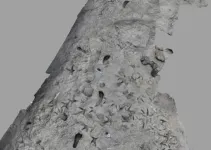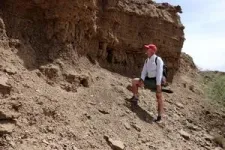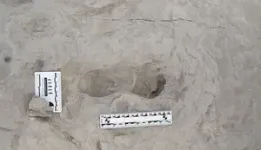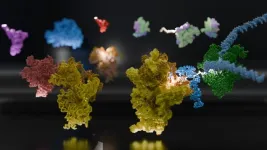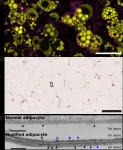(Press-News.org) More than a million years ago, on a hot savannah teeming with wildlife near the shore of what would someday become Lake Turkana in Kenya, two completely different species of hominins may have passed each other as they scavenged for food.
Scientists know this because they have examined 1.5-million-year-old fossils they unearthed and have concluded they represent the first example of two sets of hominin footprints made about the same time on an ancient lake shore. The discovery will provide more insight into human evolution and how species cooperated and competed with one another, the scientists said.
“Hominin” is a newer term that describes a subdivision of the larger category known as hominids. Hominins includes all organisms, extinct and alive, considered to be within the human lineage that emerged after the split from the ancestors of the great apes. This is believed to have occurred about 6 million to 7 million years ago.
The discovery, published today in Science offers hard proof that different hominin species lived contemporaneously in time and space, overlapping as they evaded predators and weathered the challenges of safely securing food in the ancient African landscape. Hominins belonging to the species Homo erectus and Paranthropus boisei, the two most common living human species of the Pleistocene Epoch, made the tracks, the researchers said.
“Their presence on the same surface, made closely together in time, places the two species at the lake margin, using the same habitat,” said Craig Feibel, an author of the study and a professor in the Department of Earth and Planetary Sciences and Department of Anthropology in the Rutgers School of Arts and Sciences.
Feibel, who has conducted research since 1981 in that area of northern Kenya, a rich fossil site, applied his expertise in stratigraphy and dating to demonstrate the geological antiquity of the fossils at 1.5 million years ago. He also interpreted the depositional setting of the footprint surface, narrowing down the passage of the track makers to a few hours, and showing they were formed at the very spot of soft sediments where they were found.
If the hominins didn’t cross paths, they traversed the shore within hours of each other, Feibel said.
While skeletal fossils have long provided the primary evidence for studying human evolution, new data from fossil footprints are revealing fascinating details about the evolution of human anatomy and locomotion, and giving further clues about ancient human behaviors and environments, according to Kevin Hatala, the study’s first author, and an associate professor of biology at Chatham University in Pittsburgh, Pa.
“Fossil footprints are exciting because they provide vivid snapshots that bring our fossil relatives to life,” said Hatala, who has been investigating hominin footprints since 2012. “With these kinds of data, we can see how living individuals, millions of years ago, were moving around their environments and potentially interacting with each other, or even with other animals. That's something that we can't really get from bones or stone tools.”
Hatala, an expert in foot anatomy, found the species’ footprints reflected different patterns of anatomy and locomotion. He and several co-authors distinguished one set of footprints from another using new methods they recently developed to enable them to conduct a 3D analysis.
“In biological anthropology, we’re always interested in finding new ways to extract behavior from the fossil record, and this is a great example,” said Rebecca Ferrell, a program director at the National Science Foundation who helped fund this portion of the research. “The team used cutting-edge 3D imaging technologies to create an entirely new way to look at footprints, which helps us understand human evolution and the roles of cooperation and competition in shaping our evolutionary journey.”
Feibel described the discovery as “a bit of serendipity.” The researchers uncovered the fossil footprints in 2021 when a team organized by Louise Leakey, a third-generation paleontologist who is the granddaughter of Louis Leakey and daughter of Richard Leakey, discovered fossil bones at the site.
The field team, led by Cyprian Nyete, mainly consists of a group of highly trained Kenyans who live locally and scour the landscape after heavy rains. They noticed fossils on the surface and were excavating to try and find the source. While cleaning the top layer of a bed, Richard Loki, one of the excavators, noticed some giant bird tracks, then spotted the first hominin footprint. Leakey coordinated a team in response that excavated the footprint surface in July 2022.
Feibel noted it has long been hypothesized that these fossil human species coexisted. According to fossil records, Homo erectus, a direct ancestor of humans, persisted for 1 million years more. Paranthropus boisei, however, went extinct within the next few hundred thousand years. Scientists don’t know why.
Both species possessed upright postures, bipedalism and were highly agile. Little is yet known about how these coexisting species interacted, both culturally and reproductively.
The footprints are significant, Feibel said, because they fall into the category of “trace fossils” – which can include footprints, nests and burrows. Trace fossils are not part of an organism but offer evidence of behavior. Body fossils, such as bones and teeth, are evidence of past life, but are easily moved by water or a predator.
Trace fossils cannot be moved, Feibel said.
“This proves beyond any question that not only one, but two different hominins were walking on the same surface, literally within hours of each other,” Feibel said. “The idea that they lived contemporaneously may not be a surprise. But this is the first time demonstrating it. I think that's really huge.”
END
A fossil first: Scientists find 1.5-million-year-old footprints of two different species of human ancestors at same spot
Discovery by international team, including Rutgers researcher, proves theory that some ancient hominins were neighbors
2024-11-28
ELSE PRESS RELEASES FROM THIS DATE:
The key to “climate smart” agriculture might be through its value chain
2024-11-28
In 2023, the United Nations climate conference (COP28) officially recognized the importance of agriculture in influencing and mitigating climate change. In a Policy Forum, Johan Swinnen and colleagues offer an approach to overcome challenges related to improving climate-sensitive farming practices across the globe. They discuss the importance of working with Agricultural Value Chains (AVC) by incentivizing small businesses who play an important role in the support of small- and medium-sized farms. This would involve both upstream enterprises related to seeds, fertilizer, ...
These hibernating squirrels could use a drink—but don’t feel the thirst
2024-11-28
The thirteen-lined ground squirrel doesn’t drink during its winter hibernation, even though systems throughout its body are crying out for water. Madeleine Junkins and colleagues now show that the squirrel suppresses the need to quench its thirst by reducing the activity of a set of neurons in highly vascularized brain structures called circumventricular organs, which act as a specialized connection point between brain, blood circulation and cerebrospinal fluid. The study by Junkins et al. helps explain how some hibernating animals ignore the powerful physiological drive to seek out water ...
New footprints offer evidence of co-existing hominid species 1.5 million years ago
2024-11-28
Newly discovered footprints show that at least two hominid species were walking through the muddy submerged edge of a lake in Kenya’s Turkana Basin at the same time, about 1.5 million years ago. The find from the famous hominid fossil site of Koobi Fora described by Kevin Hatala and colleagues provides physical evidence for the co-existence of multiple hominid lineages in the region—something that has only been inferred previously from overlapping dates for scattered fossils. Based on information on gait and stance gleaned from the footprints, Hatala et al. think that the two species were Homo erectus and Paranthropus ...
Moral outrage helps misinformation spread through social media
2024-11-28
Social media posts containing misinformation evoke more moral outrage than posts with trustworthy information, and that outrage facilitates the spread of misinformation, according to a new study by Killian McLoughlin and colleagues. The researchers also found that people are more likely to share outrage-evoking misinformation without reading it first. The findings suggest that attempts to mitigate the online spread of misinformation by encouraging people to check its accuracy before sharing may not be successful, the researchers ...
U-M, multinational team of scientists reveal structural link for initiation of protein synthesis in bacteria
2024-11-28
IMAGE
ANN ARBOR—Within a cell, DNA carries the genetic code for building proteins.
To build proteins, the cell makes a copy of DNA, called mRNA. Then, another molecule called a ribosome reads the mRNA, translating it into protein. But this step has been a visual mystery: scientists previously did not know how the ribosome attaches to and reads mRNA.
Now, a team of international scientists, including University of Michigan researchers, have used advanced microscopy to image how ribosomes recruit to mRNA while it's being transcribed by an enzyme called RNA polymerase, or RNAP. Their results, which examine the process in bacteria, are published in the journal ...
New paper calls for harnessing agrifood value chains to help farmers be climate-smart
2024-11-28
Washington DC, November 28, 2024: The global food system is uniquely vulnerable to climate impacts, making adaptation of paramount importance. While contributing roughly one-third of total anthropogenic emissions, food systems around the world fortunately also hold immense potential for mitigation through improved practices and land use. A new article published today in Science emphasizes the critical role of agrifood value chains (AVCs) in supporting both adaptation and mitigation at the farm level.
Authored by Johan Swinnen (International Food Policy Research Institute), Loraine Ronchi (World Bank Group), and Thomas Reardon (Michigan State University and IFPRI), the paper pushes back ...
Preschool education: A key to supporting allophone children
2024-11-28
Learning French while also developing language skills in one’s mother tongue is no easy task. As a result, allophone children often face learning and communication difficulties in kindergarten, which can negatively impact their educational journey. However, solutions are emerging.
According to a study led by Sylvana Côté, preschool education services significantly help bridge the gap between children whose mother tongue is French and those for whom French is a second or even a third language.
Professor Côté, from the School of Public Health at the Université de Montréal (ESPUM), is the director of the Observatory ...
CNIC scientists discover a key mechanism in fat cells that protects the body against energetic excess
2024-11-28
A team at the Centro Nacional de Investigaciones Cardiovasculares (CNIC), led by Professor Miguel Ángel del Pozo Barriuso, who heads the Mechanoadaptation and Caveolae Biology group at the CNIC, has identified an essential mechanism in fat cells (adipocytes) that enables them to enlarge safely to store energy. This process avoids tissue damage and protects the body from the toxic effects of accumulating fat molecules (lipids) in inappropriate places. The results, published in Nature Communications, signify a major advance in the understanding of metabolic diseases. Moreover, this discovery ...
Chemical replacement of TNT explosive more harmful to plants, study shows
2024-11-28
The increased use of a chemical compound to replace TNT in explosive devices has a damaging and long lasting effect on plants, new research has shown.
In recent years, TNT has started to be replaced with DNAN, but until now very little was known about how this substance impacts the environment and how long it can remain in the soil.
Researchers at the University of York have been studying the environmental impact of the explosive, TNT, for more than a decade. They have shown that the chemical compound, which is used by the military around the world, remains in ...
Scientists reveal possible role of iron sulfides in creating life in terrestrial hot springs
2024-11-28
An international team of scientists recently published a study highlighting the potential role of iron sulfides in the formation of life in early Earth’s terrestrial hot springs. According to the researchers, the sulfides may have catalyzed the reduction of gaseous carbon dioxide into prebiotic organic molecules via nonenzymatic pathways.
This work, which appeared in Nature Communications, offers new insights into Earth’s early carbon cycles and prebiotic chemical reactions, underscoring the significance of iron sulfides in supporting the terrestrial hot ...
LAST 30 PRESS RELEASES:
Why nail-biting, procrastination and other self-sabotaging behaviors are rooted in survival instincts
Regional variations in mechanical properties of porcine leptomeninges
Artificial empathy in therapy and healthcare: advancements in interpersonal interaction technologies
Why some brains switch gears more efficiently than others
UVA’s Jundong Li wins ICDM’S 2025 Tao Li Award for data mining, machine learning
UVA’s low-power, high-performance computer power player Mircea Stan earns National Academy of Inventors fellowship
Not playing by the rules: USU researcher explores filamentous algae dynamics in rivers
Do our body clocks influence our risk of dementia?
Anthropologists offer new evidence of bipedalism in long-debated fossil discovery
Safer receipt paper from wood
Dosage-sensitive genes suggest no whole-genome duplications in ancestral angiosperm
First ancient human herpesvirus genomes document their deep history with humans
Why Some Bacteria Survive Antibiotics and How to Stop Them - New study reveals that bacteria can survive antibiotic treatment through two fundamentally different “shutdown modes”
UCLA study links scar healing to dangerous placenta condition
CHANGE-seq-BE finds off-target changes in the genome from base editors
The Journal of Nuclear Medicine Ahead-of-Print Tip Sheet: January 2, 2026
Delayed or absent first dose of measles, mumps, and rubella vaccination
Trends in US preterm birth rates by household income and race and ethnicity
Study identifies potential biomarker linked to progression and brain inflammation in multiple sclerosis
Many mothers in Norway do not show up for postnatal check-ups
Researchers want to find out why quick clay is so unstable
Superradiant spins show teamwork at the quantum scale
Cleveland Clinic Research links tumor bacteria to immunotherapy resistance in head and neck cancer
First Editorial of 2026: Resisting AI slop
Joint ground- and space-based observations reveal Saturn-mass rogue planet
Inheritable genetic variant offers protection against blood cancer risk and progression
Pigs settled Pacific islands alongside early human voyagers
A Coral reef’s daily pulse reshapes microbes in surrounding waters
EAST Tokamak experiments exceed plasma density limit, offering new approach to fusion ignition
Groundbreaking discovery reveals Africa’s oldest cremation pyre and complex ritual practices
[Press-News.org] A fossil first: Scientists find 1.5-million-year-old footprints of two different species of human ancestors at same spotDiscovery by international team, including Rutgers researcher, proves theory that some ancient hominins were neighbors
